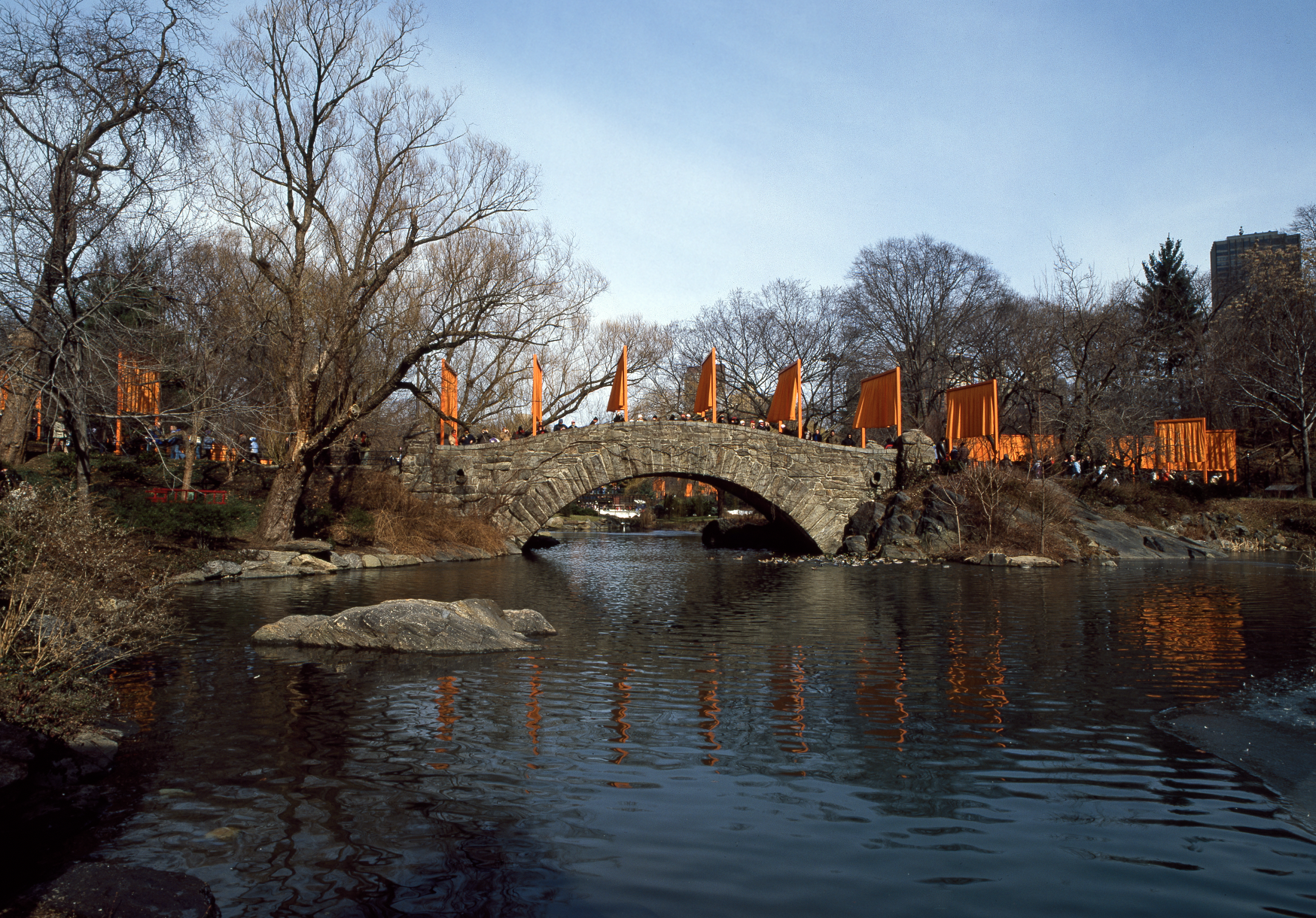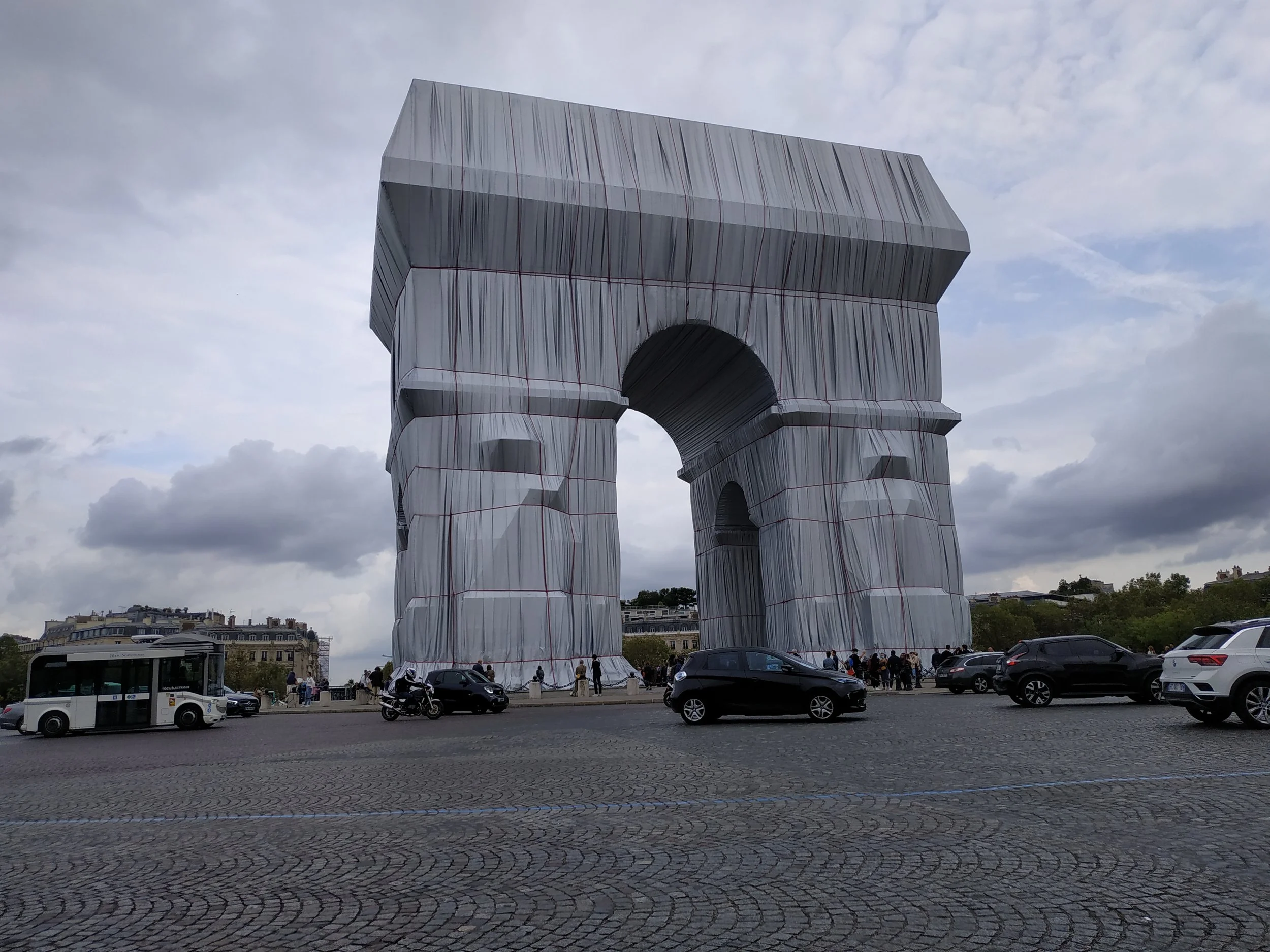Christo and Jeanne-Claude’s Experiments with Colour and Urban Environments
Throughout their careers, Christo Vladimirov Javacheff and Jeanne-Claude Denat de Guillebon created expansive installation artworks that added new structures and materials to landmarks and spaces of cultural significance. A key element of their works that is worthy of specific examination is the use of a core colour that marks the existing structure or environment, revealing its effect on the space and interaction with light in a new way.
Christo and Jeanne-Claude’s works are multi-year projects, requiring extensive planning, fundraising, and communication with government agencies to bring short-term installations to fruition. All of their installation works make significant changes to the visual and colour experience of architecture, natural landscapes, or urban environments. Christo grew up in Bulgaria during the Second World War and eventually fled the country during his military service. He received arts training at various European schools and moved to Paris in 1958. Jeanne-Claude was raised in Tunis, Morocco, and moved to Paris with her mother after completing her university studies. The two met when Christo was commissioned to paint Jeanne-Claude’s mother. From this point, the two collaborated to develop Christo’s concepts into works that experimented with the obscuration of design, from furnishings to buildings, and experimentation with intersecting large environments with temporary connective materials.
Their works vary from long expanses of fabric suspended across farmland and fields, as in Running Fence (1972-76), to temporary structures that connect or expand coastal landscapes, as in Surrounded Islands (1980-83) and The Floating Piers (2014-2016). A consistent theme across their works is the use of vibrant colours to accentuate the additions made to the existing space. Surrounded Islands used bright pink polypropylene fabric that stretched two hundred feet out from two small islands in Florida, artificially expanding the bounds of the islands. One project that stands out in its use of colour as an integral aspect of the work is The Gates. Conceived in 1979, this work took over two decades to be executed. 7,503 saffron gates were installed across every walking path and trail in New York’s Central Park. A nylon fabric of the same colour was suspended from each gate, allowing it to interact with the wind. The project was completed in 2005 and lasted for two weeks. The temporary nature of this work and others by the couple is significant, as the unique experience with structures that create a new relationship between colour and the space was specific to the season, enhanced by the winter setting.
The Gates, a site-specific work of art by Christo and Jeanne-Claude in Central Park, 2005
Image Credit: Carol M. Highsmith, Public domain, via Wikimedia Commons
Christo’s sketches envisioning the completed work show his desired interaction of the coloured fabric with the environment of the park. The fabric allowed light through, and each cloth could frame the park’s trees and its surrounding buildings in a silhouette, creating a constantly changing array of saffron hues based on each gate’s location and dependent on the time of day and wind. In this work, colour facilitates a method of viewing a small snapshot of the space, reframing the park within the bounds of a colour that was not in season. A controlled autumnal saffron was inserted into the winter park and left to transform at the will of the elements, changing the mood of the space as a result. The closeness of the gates formed a new structure, continuous along the entire park, that united the experience of the space under a shared structure and colour. The interaction of each gate with the surrounding buildings and trees was distinct, and the repeating structure of the same colour enabled this renewed attention to colour as a new frame through which to view a familiar space.
As well as their long expanses of fabric works, Christo and Jeanne-Claude also experimented with the enclosure of iconic buildings in different material wraps as a temporary spectacle within the urban environment. These works, such as Wrapped Reichstag (1971-95) and The Pont Neuf Wrapped (1975-85), obscured the architectural and spatial context of public buildings and spaces, renewing focus on their impact as monoliths of immense scale. Like with the suspended material works, these wraps used the additional motif of a new colour not normally present in the space, increasing the attention to the absence of architectural detail and allowing the new material’s colour to interact with the environment of the urban space. The wrapping of these monuments restricted their connection to their nation by obscuring their iconography and other decoration. In all cases, the form of the structure remains, drawing attention to the lasting architectural impact of the monument in its setting. Colour highlights the formal strength of the monument in the absence of its usual visual characteristics. In Christo’s last planned work before his death, only completed posthumously, L'Arc de Triomphe, Wrapped, used the subtle inclusion of the colours of the French flag to maintain some element of the structure’s national significance, yet accentuated its unchangeable interaction with light and the environment. Colour in this work facilitates a new way of seeing architecture that is integral to its city, state, and people.
Christo and Jeanne-Claude, L'Arc de Triomphe, Wrapped, 2021
Image Credit: Nicholas Sowels , Public domain, via Wikimedia Commons
Christo’s sketches for L'Arc de Triomphe, Wrapped show the way he intended the environment to constantly change the colour of the fabric, as the sun and wind ripple the material to reveal its blue undertone. Christo and Jeanne-Claude’s works are amazing examples of colour used to facilitate a grounding of individual experience with familiar urban spaces or natural environments that may often be overlooked for their particular lack of uncommon colour markers. The temporality of these works makes their use of colour all the more intriguing, as the time in which to appreciate the full experience of colour in an uncommon space has already elapsed and will not be available again. Christo and Jeanne-Claude’s works draw attention to the need to pay close attention to the architectural staples of urban environments and minute details in nature, especially in their interaction with colour.
Images
https://commons.wikimedia.org/wiki/File:The_Gates,_a_site-specific_work_of_art_by_Christo_and_Jeanne-Claude_in_Central_Park,_New_York_City_LCCN2011633983.tif
Nicholas Sowels, CC BY-SA 4.0 <https://creativecommons.org/licenses/by-sa/4.0>, via Wikimedia Commons - https://commons.wikimedia.org/wiki/File:Arc-triomphe-cristo-2.jpg
Cover Image
BriYYZ from Toronto, Canada, CC BY-SA 2.0 <https://creativecommons.org/licenses/by-sa/2.0>, via Wikimedia Commons - https://commons.wikimedia.org/wiki/File:The_Gates_(96070033).jpg



